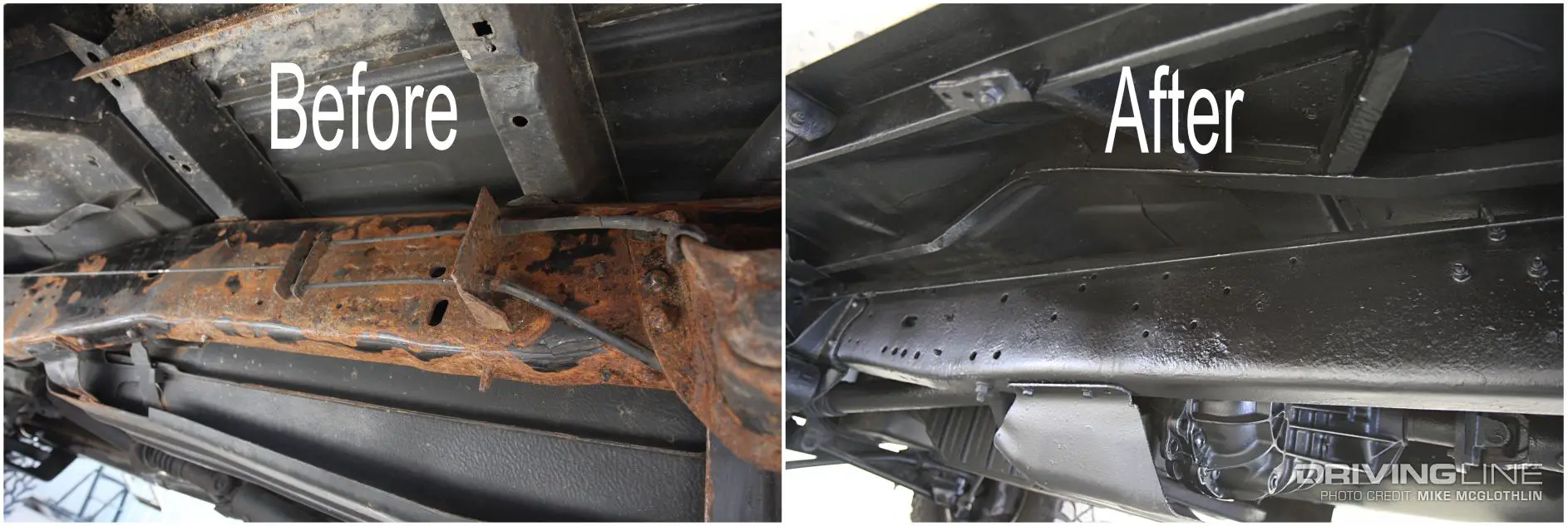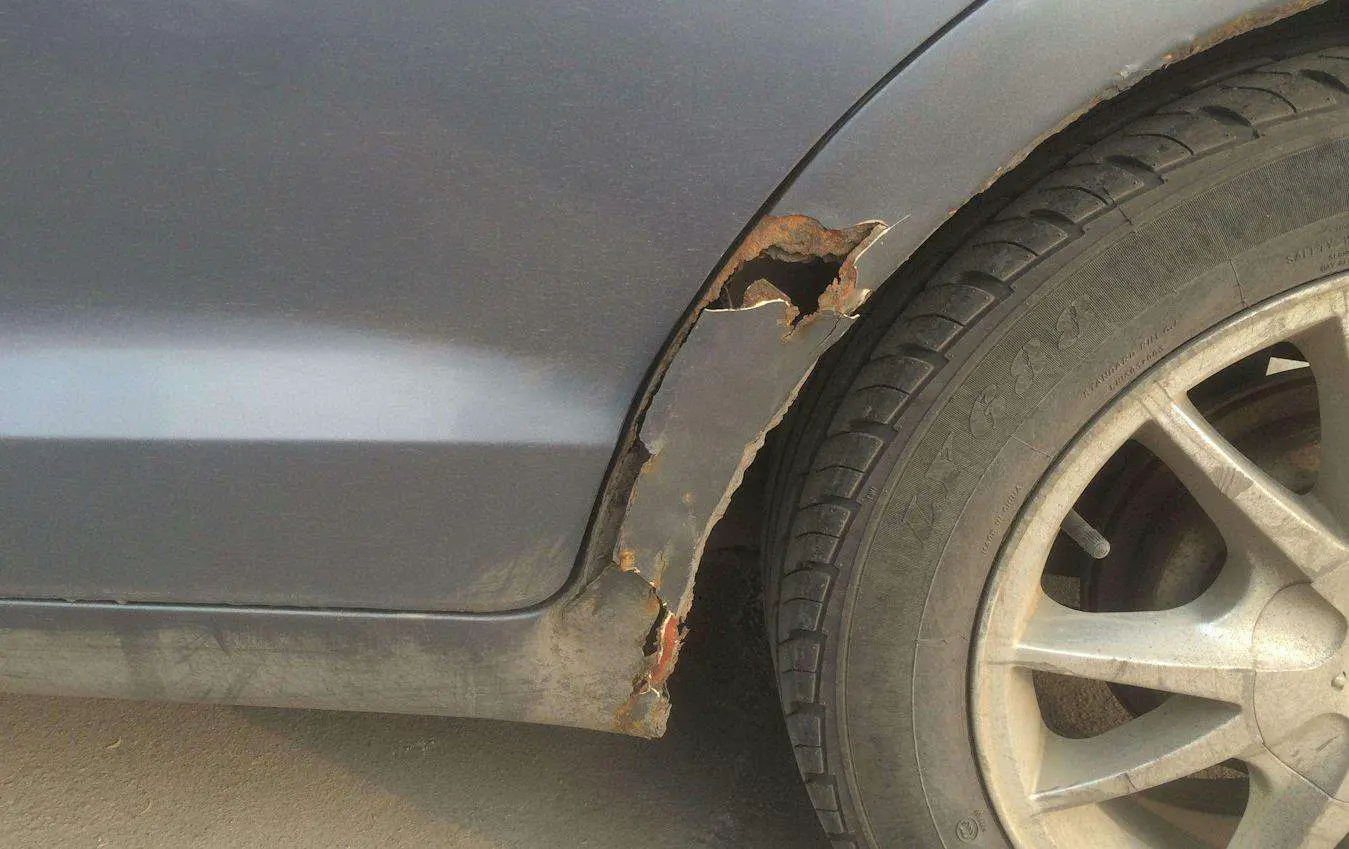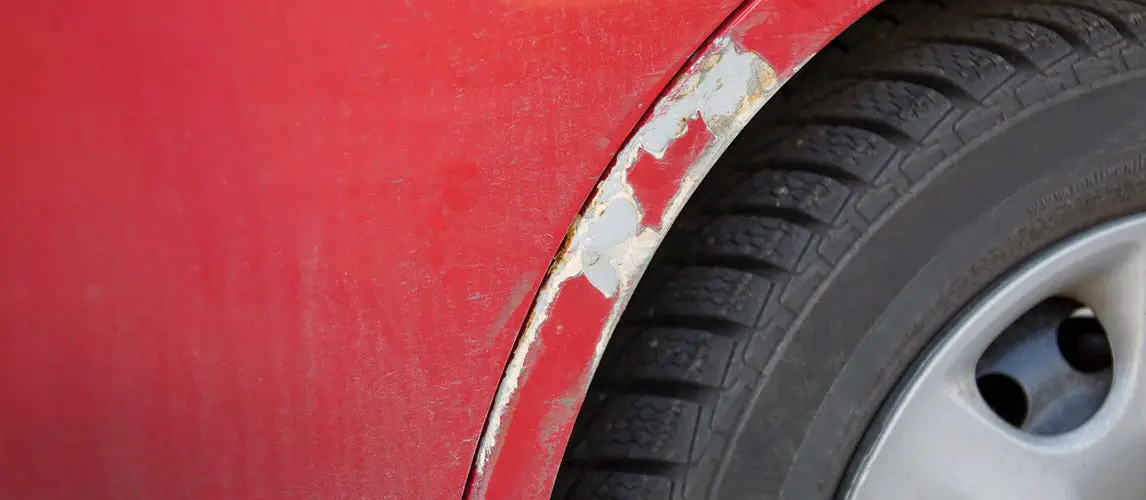How Does Rust Occur
Rust is impossible to avoid since its a natural chemical process that occurs when iron, a core component of steel, comes into contact with moisture and oxygen. The earths atmosphere has plenty of water and oxygen to spare, making it a common element of our ecosystem. Any steel exposed to the air will eventually corrode due to a process called oxidation.
However, some types of steel take longer to corrode than others. Furthermore, modern cars are manufactured with a far more durable galvanized steel, a corrosion-resistant material.
Your cars paint also plays a pivotal role in preventing rust damage. It physically prevents oxygen and water from coming in contact with the steel beneath its surface.
Generally speaking, as long as you regularly wax your car and take care of it, you probably wont have to worry much about rust. But if you have an old car you want to fix up, or your vehicle has accumulated rust from being left outside for months, there are ways you can repair the corrosion without replacing the steel wholesale.
Wash Your Car Often During Winter
Winters a bad time for your undercarriage, but you can make it better by regularly washing your car. Most automatic car washes offer undercarriage cleaning. But if you want to be thorough, you can spray the undercarriage with a pressure washer.
In terms of how often you should do it, every ten to twenty days is a good benchmark to follow. Also, you should wash your car after snowfalls, rainfalls, and whenever the temperature goes above 0-degrees during winter.
Does Vinegar Kill Rust On Cars
Yes, it does. For low grade to medium grade rust on cars, distilled white vinegar can be used to clean rust from the metal surface. Before soaking the affected area in the vinegar, use sandpaper to loosen rust from the affected area so that vinegar can actively break the bonds between the metal surface and rust molecules.
The whole process will need some time. You can use a microfiber towel to clean the area after 4 to 5 hours depending upon the severity of rust damage.
Recommended Reading: What To Wash Car With
Why Is Rust Bad For Your Car
Why is rust a danger? Because, despite irons impressive strength, iron oxide is exceedingly brittle. Think about how easy it is to crumble a flake of rust between your fingers, and then imagine that stuff trying to protect you and your loved ones during a car crash.
Most modern-day cars are engineered with extensive anti-rusting measures. These include clear-coat finishes that protect both paint jobs and body panels, as well as galvanized coatings that shield a vehicles steel body structure.
Additionally, automakers are moving away from rust-prone iron-based metals to more rust-resistant surfaces such as aluminum and carbon fiber. These materials may have their own issues, but because they dont contain iron, rust wont be one of them.
Wash And Wax Your Car Regularly

This may sound obvious, but it is one of the most important ways to stop rust on your vehicle. Typically, most car owners choose to wash their cars just once a month. This leaves an ample amount of time for dust as well as debris to continue causing harm to the car leading to the formation of rust.
Also, organic compounds present in bird droppings may lead to chemical reactions on the coat of the vehicle, causing further damage if not cleaned. Automatic fluids such as automatic transmission fluids are also leading causes of rust formation when they spill on the car surface.
Also Check: What Type Of Car Do I Have
How Do You Neutralize Rust On A Car
Rust neutralization is a method adopted by automotive detailers and DIY repair experts before performing car paint and waxing. Neutralizing rust on your car basically means removing corrosion from the car. An abrasive agent, such as an abrasive wheel or sandpaper of different grits, is usually used to cut through the surface of the corroding area and car metal till a clear metal surface is visible. The next step is to finally prime the car metal surface, apply car paint, add a clear coat, apply wax, and buff it to eliminate any blemishes.
Tips On How To Remove Rust From Your Car
Rust is like cancer once it lands on an iron-containing metal. If that metal is a part of your daily driver, you know you need to act first before it affects its effective functioning and, eventually, its safety level. If youve spotted signs of corrosion on your vehicle, this diy car rust treatment guide is yours. Read on as our team shares important tips for removing rust from your car at home.
Also Check: What Do I Need To Register My Car In California
What If You Dont Stop Rust On Your Car
If you dont do anything about stopping rust on your car, your cars life span will shrink, and the exterior part of your car will be looking like junk. The cars value also gets deprecated, and no ones ready to pay good money for your car if you ever want to sell it.
It also costs expensive to get your car free from rust after it has covered most of the car parts because that requires your car to go through many processes and use expensive materials.
So its essential to keep your car with proper care and prevent it from rust from the initial days.
How Much Rust Is Too Much
With additional reporting from Rick Popely
As cars age, one of their biggest enemies is rust. If rust gets into a vehicles frame or body structure, it can become a safety issue for drivers. Cars and trucks today are carefully engineered for crash protection, but if rust causes just one component to fail in a crash, there can be tragic consequences. In fact, if a vehicles structure gets rusty enough, there could be a catastrophic failure even in routine daily driving.
That doesnt mean that a little rust makes a used car a bad idea. The key is knowing how much rust is too much.
Also Check: How To Remove Scratches From A Car
How Fast Does Rust Spread
To spread, rust requires the same three elements mentioned at the beginning of the article . What causes spreading is water getting under the adjacent protective coating or paintwork of a rust affected area and finding its way into neighboring areas already compromised by a missing sealant or protective coating.
The only way to stop rust from spreading is to have the rust removed, or completely seal around the area to prevent water from entering. A small bubble or pinhole is an early warning sign that rust is beginning to take hold.
How much time you have to repair the rust before things get serious depend on a number of factors including average air temperature and humidity at your location, how clean the metal is, how many contaminants are in the metal and the composition of the steel. Only a professional will be able to give you a true assessment of how bad your rust problem is.
Repair Small Surface Rust Areas
Surface rust areas require sanding out the rust stain and recoating the surface with paint. Heres how to get the job done:
Also Check: What Happens If You Damage A Rental Car
How Long Do I Soak The Metal In Vinegar To Remove Rust
Distilled vinegar is a mild rust remover. The time for which you need to soak the metal in the vinegar depends upon the size of the object as well as the extent of the rust. For bigger sized objects like car metal surfaces, 5 hours to a few days of soaking is needed before the vinegar can actually act on the rust.
Safer And More Reliable

Rust weakens the parts of the car, which causes the car to become less reliable. When the car is less reliable, it doesnt guarantee safety and less damage to the car from an accident. So when you keep the car-free from rust, its parts stay in good condition and ensure to provide you more safety and less damage to the car during a collision.
Read Also: How To Jump Start My Car
A Better Way To Stop Rust: Rust Bullet
When Rust Bullet is applied over rusted metal it penetrates the substrate, dehydrates the rust, until reaching the metal. This allows the resin to become intertwined with the rust, then becomes part of the coating and solidifies into an armor tough coating with phenomenal adhesion.
Undercarriage of Mustang After Rust Bullet Automotive Applied
Apply The Colored Base Coat
- Holding the spray can about 12 in. away from the surface, spray the repaired area.
- Start at the bottom of the repair and apply the color coat in left-to-right rows, overlapping each pass by about one-third.
- Build the color slowly into the repair and surrounding areas in two to three coats.
- Allow about 10 to 15 minutes between coats.
- Allow the base coat to dry, until it’s dry to the touch, at least 60 minutes.
- Pro tip: Don’t sand the base coat unless you’ve created sags. In that case, sand lightly and then respray the touched-up areas.
Recommended Reading: What Does A Car Battery Do
How To Stop Rust From Forming
The good news is that this kind of vehicular decay is largely preventable. The best advice is the most obvious: Wash your car regularly to keep the body and underside clean of the road grime, salts, and dirt that lead to corrosion. Many modern car washes can blast the underside of your car with water to get much of this grime off.
The not-so-obvious advice is to check the drain holes along the bottoms of doors and rocker panels, which allow rainwater to flow out. Use a pipe cleaner to clear these holes out, and keep the cars nooks and crannies dry. WD-40 can be a useful tool here as well. This lubricant protects parts from corrosion, and its thin nozzle can be used to reach tight underbody spots and blast away water or corrosive grime.
As noted earlier, many vehicles have a thick coating on the underside that chemically seals the steel against oxidizing agents. Regular inspection and repair of the spots that have worn bare will keep rust from advancing and causing additional damage. If this coating is not there, consider adding one yourself. POR-15 is one of the more popular examples of such a rust-protective sealant, and they even have a rubberized coating to go over it in case you want even more protection underneath your car. As with other rust repairs, sand off any rust that might be sticking through and rough up the area you intend to paint with some sandpaper, then brush or spray the new coating on.
The Different Types Of Rust On Car
Not all rust on cars is the same. So the first way to get the rust off a car is to find out the type you’re dealing with. The three types of rust are surface rust, scale rust, and penetrating rust.
- Surface rust
Surface rust is rust that’s in its earliest form. The rusting part of the metal is only the top part of the car body. You must treat surface rust quickly before it becomes worse.
- Scale rust
Scale rust happens when you allow surface rust to remain on the metal. Rust starts to create small pits on the metal surface, and corrosion becomes harder to control. Treatment for scale rust should be very aggressive as you need to save much of the metal as you can. Scale rust reduces the strength of the metal
- Penetrating rust
Penetrating rust is the worst kind of rust because it has already corroded the metal enough to create holes on the metal. Its too late to remove rust from the car with penetrating rust. A complete and costly body overhaul is needed. When penetrating rust is present, steel becomes very brittle and is now known as iron oxide.
Also Check: Which Is The Fastest Car In The World
Protecting Your Undercarriage From Rust: Why Its Important
There are two main reasons why rustproofing your undercarriage is important. First, it will save you money in the long run. Rust repairs can cost you anywhere between $30 to $2,000, depending on the extent of the damage. Sometimes, theres nothing more to be done to treat rust damage than to entirely replace the affected vehicle part. Even the slightest spot of rust will bring your cars resale value way down.
Secondly, and more importantly, rustproofing will make your car safer, as rust can affect the structural integrity of your vehicle. Furthermore, rustproofing will help prevent leaks and other mechanical failures, which can be costly as well as dangerous.
Protection against rust is particularly important in cities that experience snowy winters, such as Edmonton. During winter, cities like Edmonton spread ice-melting road salt on streets to keep them from becoming dangerously slippery. Thats good news for public safety, but bad news for your undercarriage. Salt accelerates the formation of rust when it combines with water and oxygen. Over time, and;especially during winter, it accumulates under your vehicle and starts to do damage.
Inspect Thoroughly For Early Detection Of Rust
Another important way to stop rust on your car is to inspect for rust. Try to identify all the spots where rust can find its home. The exterior surfaces indicate the presence of rust when you see blisters or bubbles on the paint. The blisters and bubbles are usually an initial stage of the commencement of rust. Advanced rust, on the other hand, has a reddish-brown color and displays a flaxy texture. Advanced stubborn rust often damages the car surface at an incredibly fast rate and, if not stopped, causes irreversible damage.
The other two areas that are most susceptible to rust include the undercarriage as well as the car engine. Use a flashlight for the inspection, so it is easier for you to identify the rusty parts. Always remember to inspect the wheels, side-mirror connection points, the antennae, drain holes, and other places where body components meet. Remember that if you do not identify rusty spots early enough, it may cause irreversible damage to the affected area, and you may have to replace the whole part immediately with a custom made one.
Don’t Miss: What Do You Need To Get Your Car Inspected
How Difficult Is The Rust Removal Process
Since the extent of rusting will be different in every case, it can be hard to gauge the exact amount of time you will need to spend to get rid of it. Sometimes it can be a simple task that only takes an hour or so, while in other cases serious repairs may need to take place over the course of a couple of days.
Many times, the true extent of the damage will not be immediately revealed. For instance, an area that has 2 or 3 small rust bubbles, once stripped and cleaned may reveal several large rust holes in the panel, that needs to be replaced. You should try and pick a time to work on maintenance when the weather is good and allows you to work in an open area outside where you will get plenty of ventilation. You dont want to get caught in the rain in the middle of repairs, so its worth tuning in to your local weather before getting started. Always assume worst case on the area you are working on, and have a plan for complete panel cut out / replacement if the repair turns out worse than expected.
While not the easiest DIY car repair, rust removal is something that you can do on your own. If youve never done similar maintenance before then you may want to find additional information and tutorials to help give you the know-how to get the job done right the first time.
What Is The Difference Between Rust Remover And Rust Converter

In the automotive world, rust converter is often misused with rust remover. However, both of these terms are very different. Rust converter has a phosphoric formulation that picks up the rust and converts into a ferric phosphate. The ferric phosphate layer has a black color and it forms a polymeric, protective layer on the car surface.
On the other hand, rust remover can be just about anything which can remove rust. Rust removers usually have more risks associated with them as they are highly corrosive and hazardous in nature. Rust removers are very acidic and a lot of time, care, and proper administration are needed to take care of the whole process.
You May Like: How To Remove Hard Water Stains From Car
